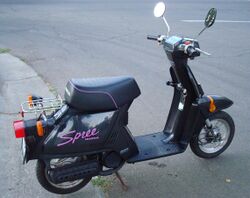Engineering:Honda Spree
From HandWiki
Revision as of 10:44, 5 August 2021 by imported>PolicyEnforcerIA (attribution)
The Honda Spree or Nifty 50 or Honda Eve (NQ50) is a 49 cc (3.0 cu in) motor scooter made by Honda in the mid 1980s. Honda marketed three different models based on the Spree's design. In some U.S. states the Spree was legally classified as a moped.
Model year changes
- 1984: The Spree was available in Sparkling Red (US Only), Cortina White, and Vista Blue (Canada Only) The speedometer design was also slightly different than the 1985-7 Sprees, instead speed numbers were 10-20-30-40, '85-7 Sprees were 5-15-25-35 The logo was also much smaller than later years.
- 1985: The Spree logo was much larger than the '84 Sprees, making it more visible.
- 1986: The Spree gets a kick starter.
- 1986: Honda also produced a "Special Edition" Spree, with a Shasta White & Lollipop Green Color combo. Nowadays this Spree is extremely rare and hard to find, as this style was only produced in 1986.
- 1987: The dashboard, front indicators and tail lamps were redesigned to a more aerodynamic shape. Also added was a glovebox located behind the shield or front of the scooter, underneath the handlebars and in front of the floorboard.
Country Specific Differences (Nifty 50)
- AU: The Nifty was available in Red, and Dark Blue although the latter seems most common. The main visible difference from the spree is the round headlight and the curved edges of the dashboard.
- EU: The Nifty was available in Red, and Dark Blue. The main visible difference from the spree is the round headlight and the curved edges of the dashboard. Front headlights are mounted upside down on the underside of the handlebars and the rear are mounted either side of the number plate mount, therefore the luggage rack is more simple, missing the round tubing the indicators are mounted to on the AU Nifty and Spree, and the rear red reflector.
Neither of the Nifty's included an engine stop switch above the engine start switch, so the only proper way of stopping the engine was to turn off the igniton.
This article does not cite any external source. HandWiki requires at least one external source. See citing external sources. (2021) (Learn how and when to remove this template message) |


